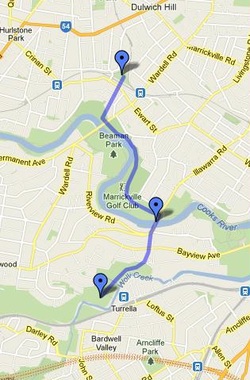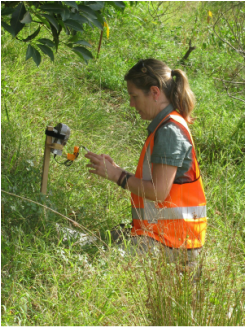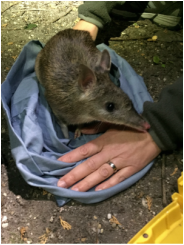|
Inner west Bandicoots
Decline and revival
Long-nosed bandicoots were once fairly common in the inner west but they disappeared in the 1950s or 1960s. After their sudden reappearance in the early 2000s, the NSW Scientific Committee in 2008 listed the inner west bandicoots as an endangered population, which means they are at high risk of extinction. Between 2002 and 2010:
Since 2010, a resident photographed a bandicoot in a Dulwich Hill backyard in February 2011 (Greenway website), and an IWEG bushcare volunteer saw one near Little St, Dulwich Hill, on July 17, 2012 (personal communication).
Yuppie bandicoots Bandicoot expert Tanya Leary from the then Department of Environment and Climate Change trapped two females in Lewisham in September 2007. She fitted them with radio collars and tracked them for several days to see where they went. The animals nested under the old Lewisham Hospital on West St – it was demolished soon after to make way for the new St Vincent De Paul Society headquarters – and under several nearby houses, especially old Federation ones with cracks in their foundations that the animals could squeeze through. Their choice of nesting sites prompted Leary and her fellow researchers to quip that “like yuppies, these bandicoots seem to like old buildings in need of renovation”. The animals were recorded foraging for food in people’s yards and the grassed common area of a retirement village/nursing home in Thomas St, where some of the residents sometimes fed them scraps of meat. A mystery Ecologists are struggling to explain why bandicoots are reappearing in the inner west after an absence of more than 50 years, but they have three theories.  Did they come from Wolli Creek? Did they come from Wolli Creek?
Theory 1. They are immigrants
One theory suggests the bandicoots found in the inner west over the past few years originated from an as-yet undiscovered population in Wolli Creek Regional Park. This theory argues the local population that suddenly appeared was made up of individuals that dispersed from a larger source population elsewhere. The problem with this theory is that no source population has yet been found. The nearest known ones are at Lane Cove National Park (11km away), North Head (15km), Garrigal National Park (15km), and Holsworthy Army Base (20km). (Leary et al. 2010) In September 2007, Department of Environment and Climate Change wildlife officers searched all 88 parks between Concord West and the Cooks River looking for the source but found nothing. Lead researcher, bandicoot expert Tanya Leary, has suggested conducting more searches along the Cooks River and possibly at Callan Park. The Australian Museum Business Services team that prepared a report on the biodiversity of the entire Marrickville municipality in 2007 suggested the animals came from a yet-to-be-discovered population at Wolli Creek, which is the largest expanse of relatively intact bush in the region. They argued bandicoots could have crossed the Cooks River using the railway bridge, entered Marrickville Golf Course and the light rail corridor via a series of small, weedy refuges. (AMBS 2007) However, Tanya Leary found no evidence of a bandicoot colony when she inspected Wolli Creek Regional Park, nor did a biodiversity survey team from the Department of Environment and Climate Change in 2008. (Leary et al. 2010) Theory 2. They have been here all along Perhaps they have lived quietly all this time in a disused industrial site, like Waratah Mills, Dulwich Hill. The bandicoots started being reported soon after the mill began being developed as apartments. The main problem with this theory is that the population is so small it would probably have been unviable over such a long time because of inbreeding. (Leary et al. 2010) Theory 3. They escaped Perhaps someone brought them here and let them go, or perhaps a breeding pair escaped from a WIRES volunteer’s house. This seems the most unlikely theory. Who would go to the trouble of doing that? Authorities have checked with WIRES and other wildlife care agencies and there have been no reports of losses. (Leary et al. 2010) |

